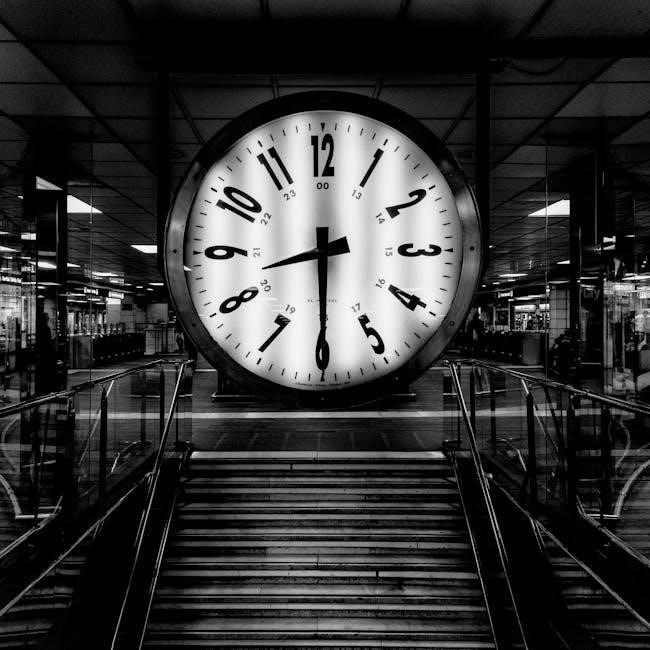Dan Wesson serial numbers provide crucial information about firearm production, including model identification, production year, and unique features like barrel length or material.
These numbers vary between revolvers and 1911 models, with distinct prefixes and conventions, aiding collectors and enthusiasts in verifying authenticity and historical significance.
1.1 Overview of Dan Wesson Firearms
Dan Wesson Firearms has been a notable manufacturer of high-quality revolvers and 1911-style pistols since the 1960s, known for their innovative designs, durability, and precision engineering.
The company gained recognition for its interchangeable barrel system and adjustable sights, features that appealed to both target shooters and law enforcement.
Over the years, Dan Wesson produced a variety of models, including the Model 44, Model 15, and Model 12, each catering to different shooter preferences and needs.
Their revolvers, particularly, were praised for their accuracy and versatility, while the 1911 pistols offered a blend of traditional craftsmanship and modern performance.
Despite changes in ownership and manufacturing locations, Dan Wesson firearms remain popular among collectors and enthusiasts, with many models becoming highly sought after for their historical significance and reliability.
The company’s commitment to quality and innovation has left a lasting impact on the firearms industry, making Dan Wesson a trusted name among gun enthusiasts worldwide.
1.2 Importance of Serial Numbers in Firearm Identification
Serial numbers are vital for identifying and authenticating Dan Wesson firearms, providing details about the model, production year, and unique features.
These numbers help determine the firearm’s history, ensuring it is genuine and not counterfeit or altered.
They also assist in tracing ownership and verifying compliance with legal regulations, making them essential for collectors and law enforcement.
Additionally, serial numbers aid in determining the market value of a firearm, as certain models or production ranges may be more sought after by enthusiasts.
Overall, serial numbers serve as a critical tool for ensuring safety, legality, and historical accuracy in firearm ownership and trade.

Structure of Dan Wesson Serial Numbers
Dan Wesson serial numbers typically consist of prefixes, model identifiers, and sequential numbers, encoding production details like model type and manufacturing date.
2.1 Prefixes and Their Meanings
Dan Wesson serial numbers often begin with specific prefixes that indicate the firearm’s model, features, or production era. For example, stainless steel models frequently have a “7” prefix, such as in the Model 744. These prefixes help differentiate between various configurations, like barrel length or material, and are crucial for identifying the firearm’s specifications. Over time, the company has used different prefix systems, reflecting changes in ownership and manufacturing processes. Understanding these prefixes is essential for decoding the serial number and determining the firearm’s history. They provide valuable insights for collectors and enthusiasts, aiding in authentication and valuation. Each prefix corresponds to specific production details, making them a key part of the serial number structure.
2.2 Numbering Conventions
Dan Wesson employs sequential numbering conventions in their serial numbers, where numbers are allocated in the order of production. These numbers are not model-specific, meaning they can overlap across different firearm models. The first two digits of the serial number often indicate the production year, while the remaining digits represent the sequential production count. For instance, a serial number starting with “22” suggests production in 2022. This system helps in tracking the production timeline and identifying the firearm’s place within the manufacturing sequence. However, variations can occur due to changes in ownership or manufacturing locations, making it essential to cross-reference with historical data for accurate identification.
2.3 Unique Identifiers in Serial Numbers
Dan Wesson serial numbers incorporate unique identifiers that provide specific details about the firearm. These identifiers often include model designations, production features, and special editions. For instance, stainless steel models are denoted by a “7” prefix in the model number, such as the Model 744. Sequential numbering ensures each firearm is distinct, while prefixes and suffixes offer additional details about the firearm’s characteristics. These identifiers help collectors and enthusiasts determine the firearm’s model, production era, and unique features. Such specifics are invaluable for authentication and historical research, making each serial number a unique code to the firearm’s identity and production history. This system enhances traceability and adds value to the firearm’s legacy.

Model-Specific Serial Number Patterns

Dan Wesson models like the 44, 15, and 12 have distinct serial number patterns reflecting their production eras and features, aiding in precise identification and dating.
3.1 Dan Wesson Model 44 Serial Numbers
The Dan Wesson Model 44, a large-frame revolver, features serial numbers starting with prefixes like ’44’ for standard models and ‘744’ for stainless steel versions.
Initial production began in 1981 with serial numbers starting at 000001, providing collectors with a clear timeline for identification and historical tracking of these firearms.
These serial numbers not only indicate production dates but also help enthusiasts verify authenticity and understand the evolution of the Model 44 over the years.
3.2 Dan Wesson Model 15 Serial Numbers
The Dan Wesson Model 15, a target revolver with adjustable sights, features serial numbers that follow specific patterns tied to production eras.
Early Model 15 serial numbers, produced from 1971 to 1975 in Monson, often start with lower ranges, while later models manufactured in Palmer from 1975 to 1995 have higher serial numbers.
These serial numbers help enthusiasts determine production dates and verify authenticity, making them invaluable for collectors and historians studying Dan Wesson firearms.
3.3 Dan Wesson Model 12 Serial Numbers
The Dan Wesson Model 12, known for its exposed or recessed barrel nut, features serial numbers that align with its production timeline from 1970 to 1971.
Early models, including those produced by High Standard, have distinct serial ranges, while later variations show transitions in manufacturing techniques and design.
Collectors rely on these serial numbers to trace the history and rarity of Model 12 revolvers, making them essential for authentication and valuation.

Decoding Dan Wesson Serial Numbers
Dan Wesson serial numbers reveal production years, models, and unique features, aiding collectors in tracing firearm history and authenticity through precise interpretation of their structure.
4.1 How to Determine the Production Year
Determining the production year of a Dan Wesson firearm involves analyzing the serial number. For many models, the first two digits of the serial number indicate the production year, such as “17xxx” for 2017. However, this method may not apply universally across all models. Historical production data and factory records are essential for accurate dating, as serial number ranges often overlap between years. Additionally, resources like the Blue Book of Gun Values and official Dan Wesson documentation provide insights into production timelines. Collectors and enthusiasts should cross-reference serial numbers with known production ranges to pinpoint the exact year of manufacture.
4.2 Identifying the Model from the Serial Number
The serial number on Dan Wesson firearms often contains specific prefixes and conventions that help identify the model. For example, large-frame revolvers are typically named after their caliber, with stainless steel versions prefixed by a “7” (e.g., Model 744 for a stainless .44 Magnum). Medium-frame revolvers and some supermags may deviate from this pattern. The Blue Book of Gun Values and historical production data provide detailed correlations between serial number prefixes and models. By analyzing the serial number’s structure and referencing these resources, enthusiasts can accurately determine the model of their Dan Wesson firearm and understand its unique features and production history.
4.3 Special Cases and Exceptions
Certain Dan Wesson models and production periods present serial number anomalies. For instance, stainless steel versions often include a “7” prefix (e.g., Model 744 for a stainless ;44 Magnum). Additionally, export models or special editions may have unique or non-standard serial number formats. Ownership changes, such as the shift from Monson to Palmer manufacturing, introduced variations in serial number patterns. Early models, like the Model 11 and 12, had distinct numbering conventions that differ from later productions. These exceptions highlight the importance of cross-referencing historical data and owner documentation to accurately decode and date Dan Wesson firearms, as serial numbers alone may not always provide complete clarity.

Historical Production Data
Dan Wesson firearms were produced across multiple eras, with early models manufactured in the 1970s-1980s, followed by mid-production in the 1990s-2000s, and modern models from 2010s-present.
5.1 Early Production Models (1970s-1980s)
Dan Wesson’s early production models from the 1970s and 1980s laid the foundation for their reputation. These models, such as the Model 11 and Model 12, were known for their interchangeable barrels and robust construction. The Model 44, introduced in the early 1980s, became iconic for its .44 Magnum chambering. Serial numbers from this era often started with specific prefixes, like “H10” for the Model H10, and ranged from simple sequences to more complex systems. Production data shows that these early models were manufactured in limited quantities, making them highly sought after by collectors today. The era also saw the introduction of stainless steel variants, marked by a “7” prefix in the model number, such as the Model 744. These early production runs were characterized by their durability and innovative design features, setting the stage for future model developments. The transition from Monson to Palmer manufacturing facilities during this period also influenced serial number conventions, with slight variations noted in documentation. Despite challenges in pinpointing exact production dates due to overlapping serial ranges, these early models remain a cornerstone of Dan Wesson’s legacy. Enthusiasts often rely on original purchaser records and historical documentation to authenticate and date these firearms accurately. The early production era not only established Dan Wesson as a reputable firearm manufacturer but also laid the groundwork for the company’s expansion into various calibers and models in subsequent decades.
5.2 Mid-Production Models (1990s-2000s)
The 1990s to 2000s saw Dan Wesson expanding its product line with models like the Model 14 and Model 15, which were popular for their versatility and durability; These mid-production models often featured interchangeable barrels and adjustable sights, catering to both service and target shooting needs. Serial numbers during this era continued to follow specific conventions, with prefixes indicating model variants. The transition from Monson to Palmer manufacturing facilities introduced slight changes in serial number patterns, though the overall structure remained consistent. This period also saw the introduction of stainless steel models, such as the Model 744, which were highly regarded for their corrosion resistance. The mid-production era marked a period of refinement and innovation, solidifying Dan Wesson’s reputation as a reliable firearm manufacturer. Collectors today value these models for their balance of functionality and historical significance.
5.3 Modern Production Models (2010s-Present)
In the 2010s, Dan Wesson, under new ownership, introduced modern production models that combined heritage designs with advanced manufacturing techniques. Serial numbers became more standardized, often starting with a prefix indicating the model, followed by a sequential number. The company expanded its lineup to include variants like the Heritage and Tactical models, each with unique features. Stainless steel and specialized finishes became common, reflecting market demands for durability and aesthetics. The modern era also saw the integration of customer feedback into design, leading to models tailored for competitive shooting and concealed carry. Serial numbers from this period are more precise for dating, making them invaluable for collectors and enthusiasts seeking specific production details.

Variations in Serial Numbering
Dan Wesson serial numbers vary due to changes in ownership, manufacturing locations, and special editions, leading to unique numbering patterns across different models and production periods.
6.1 Changes in Ownership and Manufacturing
Changes in Dan Wesson’s ownership and manufacturing processes significantly influenced serial number patterns. For instance, when the company moved from Monson to Palmer, serial numbers reflected this shift, with new prefixes and numbering conventions emerging. Similarly, transitions in ownership, such as the rename to Wesson Firearms Co., Inc., introduced variations in how serial numbers were recorded and formatted. These changes often led to overlaps or discrepancies in serial number sequences, making precise dating and model identification more challenging. Additionally, different manufacturing facilities implemented their own serial number systems, further diversifying the patterns across various models and production eras, complicating research efforts for enthusiasts and collectors alike.
6.2 Stainless Steel Models and Their Serial Numbers
Stainless steel Dan Wesson models often have distinct serial number patterns, with prefixes and suffixes indicating their material and finish; For example, a stainless 44 Magnum is designated as model 744, with serial numbers starting with specific codes to denote stainless steel construction. These serial numbers may include unique identifiers or prefixes that differentiate them from blued models, aiding in quick identification. Additionally, stainless steel models sometimes follow separate numbering sequences, reflecting their production runs independently of other finishes. This differentiation helps collectors and enthusiasts trace the lineage and rarity of stainless steel variants, making them highly sought after in the firearms market.
6.3 Export Models and Special Editions
Export models and special editions of Dan Wesson firearms often feature unique serial number patterns tailored for international markets or commemorative purposes. These serial numbers may include specific prefixes or suffixes to denote their special status, such as “EXP” for export models or “SE” for special editions. Special editions, often produced in limited quantities, have serial numbers that reflect their exclusivity, sometimes with sequential numbering starting from “001.” Additionally, certain export models may have altered specifications to meet local regulations, with serial numbers encoding this information. These variations make export and special edition models highly collectible, offering insights into Dan Wesson’s global market strategies and brand collaborations.

Resources for Serial Number Research
The Blue Book of Gun Values, official Dan Wesson documentation, and online forums provide detailed serial number data, aiding in accurate firearm identification and historical research.
7.1 Official Dan Wesson Documentation
Official Dan Wesson documentation, such as factory records and owner’s manuals, offers detailed insights into serial number structures, production timelines, and model-specific features. These documents are invaluable for enthusiasts and researchers, providing authenticity verification and historical context. Many original records from past ownership changes are now digitized, making them accessible online. However, gaps in documentation exist due to prior ownership transitions and record losses. Despite these challenges, official materials remain the most reliable source for accurate serial number decoding and model identification, ensuring collectors can trace their firearms’ origins and value effectively.
7.2 Online Forums and Communities
Online forums and communities dedicated to Dan Wesson firearms serve as vital resources for serial number research. Enthusiasts share insights, historical data, and personal experiences, fostering collaborative learning. Platforms like Dan Wesson Forum host extensive discussions, offering serial number registries and production timelines. Members often post rare documents and factory records, aiding in accurate date determination. These communities also address common questions and exceptions in serial number patterns, providing practical advice for collectors. By leveraging collective knowledge, these forums bridge gaps in official documentation, making them indispensable for researchers and firearm enthusiasts seeking detailed information on Dan Wesson serial numbers.
7.4 The Blue Book of Gun Values
The Blue Book of Gun Values is a trusted resource for firearm enthusiasts, offering detailed information on Dan Wesson serial numbers. It provides historical production data, model-specific details, and insights into serial number patterns. This reference helps collectors and researchers decode serial numbers to determine production years and model variations. By cross-referencing serial number ranges with production timelines, the Blue Book aids in identifying rare or unique firearms. It also helps estimate market value and authenticity, making it an essential tool for anyone researching Dan Wesson firearms. While not exhaustive, the Blue Book complements other resources, offering a comprehensive guide for understanding Dan Wesson serial numbers.

Common Questions About Dan Wesson Serial Numbers
Common questions include the accuracy of serial numbers for dating, their role in determining firearm value, and whether serial numbers are unique across different models.
8.1 How Accurate Are Serial Numbers for Dating?
Dan Wesson serial numbers are generally reliable for dating but not always precise due to variations and overlaps in production ranges. While the first two digits can indicate the year, exceptions exist, especially during manufacturing transitions. For instance, models from the late 1970s to early 1980s often share serial number ranges, making exact dating challenging. Additionally, changes in ownership and manufacturing locations can lead to inconsistencies. Collectors and enthusiasts should cross-reference serial numbers with historical production data and official documentation for the most accurate results. Despite these limitations, serial numbers remain a valuable tool for estimating the age of a Dan Wesson firearm.
8.2 Can Serial Numbers Help Determine the Value?
Serial numbers can assist in determining the value of a Dan Wesson firearm by identifying its rarity, production era, and specific features. For example, early models or limited production runs often command higher prices. The Blue Book of Gun Values and historical data can help estimate worth based on serial number ranges. Additionally, unique identifiers within the serial number, such as those indicating stainless steel construction, can enhance value. However, market demand, condition, and provenance also play significant roles. Thus, while serial numbers are a useful starting point, a comprehensive appraisal is needed for an accurate valuation of a Dan Wesson firearm.
8.3 Are Serial Numbers Unique Across Models?
Dan Wesson serial numbers are generally unique across models, as each model line has its own distinct numbering sequence. For example, the Model 44 and Model 15 revolvers have separate serial number ranges, ensuring uniqueness. This system helps in identifying specific models and their production details. However, overlapping or shared serial number prefixes can occur, especially during transitions in ownership or manufacturing locations. Additionally, special editions or export models may have unique serial numbers that differ from standard production lines. While serial numbers are primarily unique, variations and exceptions exist, making cross-referencing with historical data essential for accurate identification.

Practical Applications of Serial Number Knowledge
Understanding Dan Wesson serial numbers aids in identifying rare models, verifying authenticity, and determining market value, essential for collectors and enthusiasts.
9.1 Collecting and Identifying Rare Models
Collectors rely on Dan Wesson serial numbers to identify rare models, such as early production revolvers or limited-edition firearms. By analyzing the serial number’s structure, enthusiasts can pinpoint specific models, production years, and unique features. For instance, stainless steel variants often have distinct prefixes, aiding in identification. This knowledge helps verify authenticity and distinguish rare models from more common ones. Serial numbers also reveal historical production trends, making them invaluable for building comprehensive collections. Rare models, like the Model 44 or early Model 12s, are highly sought after, and their serial numbers play a key role in determining their value and scarcity. This expertise enhances the collecting experience and ensures acquisitions are genuine and noteworthy.
9.2 Verifying Authenticity of Dan Wesson Firearms
Verifying the authenticity of Dan Wesson firearms is crucial for collectors and buyers. Serial numbers are a primary tool in this process, as they contain specific codes and prefixes that correlate to production details. By cross-referencing the serial number with historical records, enthusiasts can confirm whether a firearm matches its claimed model and production era. Additionally, examining the serial number’s placement and formatting can reveal inconsistencies, helping to identify counterfeit or altered firearms. This method ensures that each Dan Wesson firearm is genuine, maintaining its value and historical integrity. Serial number verification is a cornerstone of ethical collecting, safeguarding investments and preserving the legacy of Dan Wesson’s craftsmanship.
9.3 Determining the Market Value of a Firearm
Determining the market value of a Dan Wesson firearm involves analyzing its serial number, production era, and condition. Serial numbers provide insights into rarity and demand, while production dates help assess historical significance. For instance, early models from the 1970s and 1980s often command higher prices due to their scarcity. The Blue Book of Gun Values and auction data are essential tools for evaluating market trends. Condition, including original finishes and accessories, also plays a critical role. By combining serial number research with market analysis, collectors and sellers can accurately determine a firearm’s value, ensuring fair transactions and informed decision-making in the competitive firearms market.